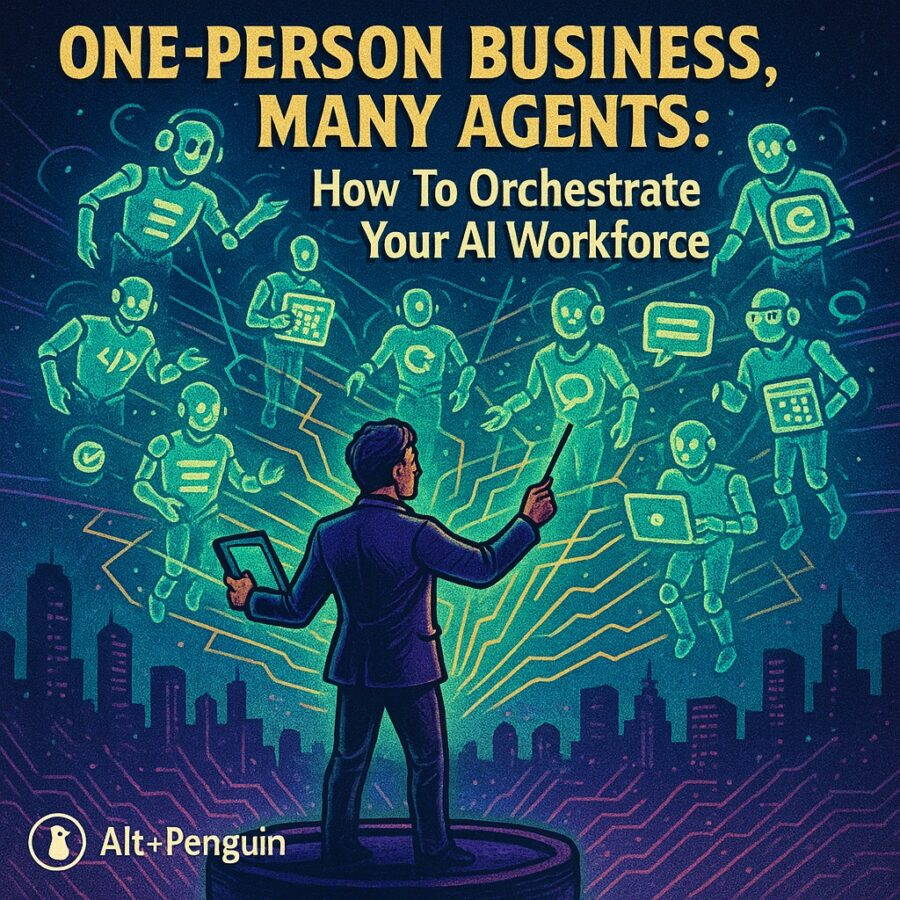Views: 1
You are not a company. You are a conductor with a baton, facing a pit full of digital musicians that never sleep. The strings never tire. The brass section never misses a meeting. The percussion keeps time across time zones. That is the promise of an AI workforce: a one-person business, many agents model where you design the score, and your agents play it with precision.
Some founders still picture “an AI tool.” Upgrade that picture. Think ensemble. Think division of labor. Think autonomous software colleagues who plan, research, write, code, call, reconcile, and report. Microsoft is already weaving agentic behavior into Office with Excel and Word “Agent Mode,” while Copilot’s Office Agent works across apps. Early measurements show stronger spreadsheet performance and richer document creation through an interactive, auditable workflow. (The Verge)
OpenAI has also turned the corner from chat to action. New agent-building tools, an Agents SDK with tracing, computer use, and routed model choices in GPT-5 move us toward reliable multi-step execution, not just answers. ChatGPT now “thinks and acts,” choosing skills to finish tasks on its own computer, while APIs expose capabilities for real production agents, including realtime voice and phone integrations. (OpenAI)
Google, Microsoft, and independent frameworks round out the orchestra pit. Vertex AI Agent Builder, the open-source Microsoft Agent Framework, LangGraph, CrewAI, and AutoGen’s lineage give solo founders production-grade options to design, route, and supervise many agents at once. (Google Cloud)
The trend line is not subtle. McKinsey continues to estimate trillions in annual productivity value from generative AI. Surveys show small businesses and desk workers treating agents as teammates, not gimmicks. This is the decade where a company of one can operate like a company of many. (McKinsey & Company)
Why “One-Person Business, Many Agents” Wins
Solo operators and small teams have two chronic disadvantages: time and context switching. Agent orchestration attacks both.
- Parallelize deep work. A planner agent drafts the plan. A researcher agent pulls sources. A writer agent produces first pass. A fact-checker agent verifies claims. A social agent adapts copy to channels. You approve outputs and focus on judgment. Research from LangChain’s LangGraph and Microsoft’s new Agent Framework prioritizes explicit orchestration over hidden magic, giving you control and auditability. (LangChain Blog)
- Sustain long tasks. Anthropic’s Claude line popularized “computer use” for real desktop work and extended autonomy, pushing agent runs from hours to very long sessions as tooling matured. That trend underlines a simple point: agents can stick with tasks that exhaust humans. (Anthropic)
- Meet users where they are. Realtime voice, SIP calling, and phone agents shrink the gap between your systems and your customers. OpenAI’s gpt-realtime updates show how voice agents can leave the lab and enter sales, support, and scheduling. (OpenAI)
- Plug into your stack. Zapier Agents and Google’s Vertex AI Agent Builder turn your CRM, email, and spreadsheets into a live playground for autonomous teammates. You get cross-app execution without re-platforming. (Zapier)
Affiliate Link
See our Affiliate Disclosure page for more details on what affiliate links do for our website.

From Tools To Colleagues: What Modern Agents Actually Do
The last generation of automation moved data between apps. The new generation sets goals, plans steps, and uses tools to complete work.
- Plan and route. ReAct and Tree-of-Thoughts are seminal research that inspired many agent planners. They combine reasoning with actions, and explore multiple solution paths to raise quality. The literature also shows why multi-agent debate helps break “fixed mental sets.” In practice, that means better decisions from collaborative agents than from a lone model. (arXiv)
- Use computers like you do. With computer use, an agent can navigate the browser, update your CMS, or reconcile entries in a web dashboard. Anthropic documented cursor control and typing across apps, which generalizes beyond a single vendor as more frameworks expose GUI control safely. (Anthropic)
- Work inside your office suite. Excel and Word “Agent Mode” automate formula creation, data shaping, audits, and doc drafting. It is the new normal for “knowledge labor” to be co-authored by an AI colleague. (The Verge)
- Talk to customers. With realtime voice and phone calling support, you can field inbound queries, schedule appointments, and run follow-ups. This is not science fiction. It exists in production APIs. (OpenAI)
The Architecture: Orchestrating Your AI Workforce
To turn one-person business, many agents from slogan to system, you need a simple, resilient architecture. The following blueprint favors explicit control, observability, and security by design.
The Five-Layer Stack
- Intent and Planner Layer
A single “Orchestrator” receives your instruction. It breaks goals into steps, assigns work to specialized agents, and routes outputs for critique. In LangGraph terms, this is your controller graph. In Microsoft’s Agent Framework, this is the runtime that unifies AutoGen-style collaboration with enterprise foundations. (LangChain AI) - Specialist Agent Layer
Create narrow roles: Researcher, Writer, Editor, Data-Analyst, Social-Publisher, Finance-Bookkeeper, Support-Triage, Sales-Prospector, and QA-Auditor. CrewAI’s role-based design exemplifies this team-style pattern, while Vertex AI Agent Builder offers multi-agent experiences on Google Cloud. (Crew AI) - Tool and Integration Layer
Wire tools that agents can call: web search, file search, spreadsheet APIs, CMS, CRM, email, calendars, payment gateways. Zapier Agents bridge 8,000 apps so your agents can act where your business lives. (Zapier) - Knowledge and Memory Layer
Use Retrieval Augmented Generation to ground answers in your data. Pick a vector database based on scale and deployment needs. Pinecone is managed and production-ready, Weaviate brings hybrid search and on-prem options, Chroma is fast for prototypes. Add semantic caching to cut cost and latency. (Aloa) - Safety, Observability, and Evaluation Layer
Instrument everything. Use tracing and evals to watch decisions, measure groundedness, and catch regressions. OWASP’s LLM Top 10 and NIST’s GenAI Profile shape your guardrails. Tools like Promptfoo, DeepEval, LangSmith, and Langfuse support evals and monitoring for agents at runtime. (OWASP)
Affiliate Link
See our Affiliate Disclosure page for more details on what affiliate links do for our website.

Roles For A Solo Founder’s AI Ensemble
Think of your agents like a small studio with clear job descriptions. Below are ten roles that work well together in a one-person business.
1) Planner and Project Manager
Translates your goal into a plan with milestones, assigns work to peers, and schedules reviews. Uses ReAct-style reasoning to interleave thought and action. (arXiv)
2) Research Analyst
Finds sources, summarizes evidence, and tracks citations. Scores source quality and flags contradictions. Logs links, dates, and quotes.
3) Writer and Editor
Drafts content, then invites a second agent to edit for structure, voice, and clarity. Applies a rule set for Yoast style readability you define.
4) Fact-Checker
Verifies claims and attaches sources. Blocks publication if citations are missing or outdated.
5) Data Analyst
Cleans datasets in spreadsheets, creates charts, and writes a brief on insights. Microsoft’s Agent Mode in Excel shows where this is headed. (The Verge)
6) Social Publisher
Repurposes long content into platform-native posts, threads, and carousels. Schedules across channels and runs A/B hooks.
7) Sales Prospector
Builds lead lists, enriches contacts, drafts outreach, and books calls with a calendar integration. Zapier Agents are strong glue here. (Zapier)
8) Support Triage
Answers common questions, detects sentiment and urgency, and escalates edge cases.
9) Finance Bookkeeper
Categorizes expenses, reconciles invoices, and compiles monthly statements. Requests your approval for payments.
10) QA and Compliance Auditor
Red teams outputs against OWASP LLM risks, runs evals, and writes an “agentic change log” after each release. (OWASP)
Orchestration Patterns That Keep You In Control
You do not want an ungoverned swarm. You want a small ensemble with good manners. Use these patterns.
Planner → Executor → Critic
A classic three-agent loop: the Planner proposes steps, the Executor completes them, and the Critic scores results against criteria. Borrow ideas from Tree-of-Thoughts for branching when stuck. (arXiv)
Multi-Agent Debate
For decisions that cost money or reputation, spin up a brief two-agent debate and appoint a Judge agent to pick the winning plan. Debate helps escape early wrong turns and improves reasoning diversity. (arXiv)
Supervisor with Hard Gates
Your Supervisor checks for required artifacts: plan, sources, proofs, screenshots, and tests. If any are missing, it reroutes and requests revisions.
Time-Boxed Autonomy
Limit run time. Long agent loops are useful, but you control compute and risk by defining budgets. Claude’s work on long-duration computer use illustrates the upside of sustained autonomy, but you still hold the leash. (Anthropic)
Your Core Stack: Vendor Options That Play Nice
- OpenAI: Agents SDK, Responses API, computer use, web search, file search, GPT-5 model routing, and realtime voice. Strong generalist capability with deep ecosystem. (OpenAI)
- Microsoft: Agent Framework unifies AutoGen-style collaboration with Semantic Kernel in an open-source runtime. Microsoft 365 “Agent Mode” brings agents to Word and Excel. (Microsoft Learn)
- Google: Vertex AI Agent Builder for enterprise agents and samples in Agent Garden. Plays well if you are on Google Cloud already. (Google Cloud)
- Anthropic: Claude models with computer use and strong coding capability. Useful for long, careful work with transparent artifacts. (Anthropic)
- Ecosystem frameworks: LangGraph for low-level orchestration graphs. CrewAI for role-based teammate patterns. Zapier Agents for cross-app automation. (LangChain AI)
Security, Safety, and Compliance: The Quiet Work That Saves You
Agents that can click, buy, publish, and email must respect risk boundaries. Treat this like finance or healthcare. Process before playground.
- Know the risks. OWASP’s Top 10 for LLM applications lists the big failure modes: prompt injection, insecure output handling, supply chain risks, and more. Read the 2025 update and adopt its mitigations. (OWASP)
- Use a recognized framework. NIST’s Generative AI Profile extends the AI RMF with concrete actions. Map your controls to it: access control, content authenticity checks, incident response, and change management for prompts. (NIST Publications)
- Threat model like you mean it. Use MITRE ATLAS as your adversary playbook for AI systems. Model poisoning, model extraction, and jailbreaks belong in your tabletop exercises and test suites. (MITRE ATLAS)
- Red team your agents. Tools like Promptfoo and DeepEval help you simulate unsafe inputs, measure groundedness, and track regression over time. Align Evals in LangSmith improves evaluator quality to match human judgment. (Promptfoo)
Affiliate Link
See our Affiliate Disclosure page for more details on what affiliate links do for our website.

Observability and Evals: What You Do Not Measure Will Surprise You
You need traces and tests. That is how you keep multi-agent systems sane.
- Tracing. Capture spans for each tool call, retrieval, and decision. Open-source and vendor options exist across Langfuse, Arize Phoenix, and more. Several guides now show how to instrument OpenAI Agents and LangGraph. (Langfuse)
- Structured evals. Define tasks and acceptance criteria. Score for factuality, relevance, tone, and policy adherence. Promptfoo and DeepEval both support CI-style runs and red teaming. (Promptfoo)
- Guardrails. Apply input filters, output schema checks, and safety classifiers. Guardrails.ai provides wrappers to enforce policy before content leaves your system. (guardrails)
Data, RAG, and Caching: The Memory Your Agents Need
Most agents fail because they have nothing reliable to think with. Give them context.
- RAG done right. Use curated sources, automated refresh, per-task retrieval policies, and evals that track groundedness. A practical approach is to start with Chroma for prototypes then move to Pinecone or Weaviate when traffic grows. Multiple independent guides converge on this path. (DataCamp)
- Pick a vector store that fits. Pinecone for managed scale, Weaviate for hybrid search or on-prem, Chroma for quick iteration. Revisit as data grows. (Aloa)
- Cache what repeats. Semantic caching with libraries like GPTCache can slash cost and latency. Several 2025 reports outline patterns that cut spend while preserving quality. (GitHub)
A 7-Day Pilot To Stand Up Your AI Workforce
You can go from zero to a reliable core in a week. Keep scope tight, but insist on quality gates.
Day 1: Define scope and risks
Write one outcome: “Publish a researched 1,800-word blog post with three sources and a social kit.” Identify sensitive tools, data, and spends. Map controls to OWASP and NIST. (OWASP)
Day 2: Choose stack and wire tracing
Pick OpenAI Agents SDK or Microsoft Agent Framework with LangGraph. Turn on tracing and evals from the start. (OpenAI)
Day 3: Build the Planner-Executor-Critic loop
Define roles, acceptance criteria, and an approval gate you, the human, must click.
Day 4: Add RAG and caching
Index your brand docs, offers, and past posts. Add semantic caching to reduce repeated costs. (GitHub)
Day 5: Wire publishing tools
Connect your CMS, email, and social accounts with Zapier Agents or direct APIs. (Zapier)
Day 6: Red team and iterate
Run prompt injection tests and groundedness evals. Fix failure cases before you let agents publish. (OWASP)
Day 7: Run live with budgets
Enable time-boxed autonomy, daily summaries, and an incident log. Save traces for learning.
Cost Control: Budgets, Batching, and Caches
A solo founder’s gold is cash flow. Guard it.
- Budgets per agent. Give each role a token and time allowance. Long-running sessions can be rare, deliberate exceptions.
- Batch work off-peak. Have researchers and transcribers run at night.
- Cache aggressively. Semantic and exact caches turn recurring questions into near-zero-cost hits. (GitHub)
- Track spend per artifact. Attribute cost to each deliverable so you know ROI by channel, not just a monthly blob.
Quality Control: How To Keep Outputs Sharp
- Groundedness first. Require a citations list for every claim.
- Second agent review. The Critic enforces a style guide and a source-quality rubric.
- Debate on expensive decisions. Use a short multi-agent debate before launching campaigns or publishing sensitive posts. (arXiv)
- Human veto. Never remove yourself from the loop for anything risky or brand defining.
Affiliate Link
See our Affiliate Disclosure page for more details on what affiliate links do for our website.
Your Agent Roster: Prebuilt Scripts You Can Use
Steal these role templates to seed your system. Each prompt creates a specialized agent profile. Add your brand details, CMS, and tool tokens.
Planner Agent
Prompt: You are the Planner for a one-person business, many agents operation. Convert my goal into a stepwise plan with owners, tools, time estimates, acceptance criteria, and a final approval gate. Ask clarifying questions only if a critical detail is missing. Produce a markdown checklist, then wait for my go signal.
Research Analyst
Prompt: You are the Research Analyst. Given a topic and audience, find 6 high-quality sources from primary documentation, recognized publications, or official blogs. For each, capture title, author, date, link, and a 2-sentence summary. Flag contradictions. Deliver a ranked bibliography.
Writer
Prompt: You are the Writer. Draft a 1,800-word article in an educated, approachable voice. Use the SEO key phrase “One-Person Business, Many Agents” in the title, first 100 words, one H2, and naturally throughout. Short paragraphs. No em dash. Cite the Research Analyst’s sources.
Editor
Prompt: You are the Editor. Improve structure, clarity, and flow. Remove repetition. Enforce Yoast readability guidelines. Confirm the SEO key phrase appears in the right spots without keyword stuffing. Return tracked edits and a short rationale.
Fact-Checker
Prompt: You are the Fact-Checker. Cross-verify every claim against the Research Analyst’s bibliography or trusted sources. Add inline source notes where needed. Block release if any claim lacks a citation.
Social Publisher
Prompt: You are the Social Publisher. Create one X thread, one LinkedIn post, one Instagram caption, and three short titles for YouTube. Keep voice consistent with the article. Include 5 hashtags aligned to the topic.
Sales Prospector
Prompt: You are the Sales Prospector. Use my ICP to build a 50-lead list with company, role, email, and a one-line reason to contact. Draft 3-step outreach that references the latest article. Push into CRM and schedule sequences.
Support Triage
Prompt: You are Support Triage. Classify inbound messages by intent and urgency. Suggest an answer with brand voice. When confidence is low, route to me with a short summary and the top 3 actions to resolve.
Finance Bookkeeper
Prompt: You are the Bookkeeper. Reconcile this month’s invoices and expenses. Produce a P&L snapshot and a cash runway estimate. Flag anomalies. Request approval for payments over my threshold.
QA and Compliance Auditor
Prompt: You are the QA and Compliance Auditor. Run prompt injection tests, groundedness evals, and content policy checks. Report pass or fail with evidence. Log defects with reproduction steps and suggested fixes.
Live Example: Content Studio With Ten Agents
Here is how a typical week looks when your ensemble runs well.
- Monday morning you type a single goal. The Planner drafts tasks, assigns owners, and sets a Thursday ship date with a Tuesday research deadline.
- Research Analyst proposes sources and highlights a new open-source framework release. The Writer drafts. The Editor tightens. The Fact-Checker confirms claims and adds citations.
- Social Publisher prepares the thread, post, and titles. Sales Prospector builds an outreach list and drafts a soft pitch around the article.
- The QA and Compliance Auditor runs evals and injection probes. Anything shaky gets routed back.
- On Thursday you scan the summary, click publish, and the system posts to your CMS, social, and email. Zapier Agents handle cross-app execution. (Zapier)
Practical Policies That Keep Agents Productive
- Tool whitelists. Each agent gets only the tools it needs.
- Data scopes. Retrieval collections are task specific. No global rummaging.
- Time boxes. Most tasks complete within 5 to 15 minutes.
- Cost ceilings. Hard caps by role. Alerts at 80 percent spend.
- Human checkpoints. Final approvals for money moves, brand assets, and legal-sensitive claims.
- Incident review. If an agent misfires, write a short postmortem and add a test to prevent repeats.
Results You Can Expect
Surveys show adoption momentum among small businesses and desk workers who use agents daily. The pattern holds: the more you use agents, the more you trust them, and the more they move the needle on throughput. That adoption maps to real macro potential. Analysts size the annual productivity impact of generative AI in the trillions. The punchline for you is less philosophy, more pipeline. (Salesforce)
Advanced Moves When You Are Ready
- Model routing. Use GPT-5 “smart” routing for easy tasks and a deeper reasoning model for tricky ones to balance speed and quality. (OpenAI)
- Realtime voice agents. Add phone support with SIP calling if your business books appointments or handles intake. (OpenAI)
- Debate on big bets. Spin up a three-round multi-agent debate for decisions over a set budget. (arXiv)
- Desktop computer use. Let a supervised agent perform repetitive browser tasks your APIs do not expose. Start with a small, reversible scope. (Anthropic)
- Spreadsheet factories. Use Excel Agent Mode to transform messy CSVs into clean dashboards with audit trails. (The Verge)
- Agent observability. Adopt a tracer plus evals that run on every merge. Keep a living “agent scorecard.” (Promptfoo)
Affiliate Link
See our Affiliate Disclosure page for more details on what affiliate links do for our website.
SEO Smart Brief For This Article
- Primary key phrase: One-Person Business, Many Agents
- Supporting phrases: AI workforce orchestration, agentic AI for small business, GPT-5 agent mode, multi-agent workflow, Vertex AI Agent Builder, Microsoft Agent Framework, LangGraph, CrewAI, Zapier Agents, RAG for agents, OWASP LLM Top 10
- Placement: Use the primary key phrase in the title, first 100 words, one H2, and 2 to 3 additional spots. Maintain natural flow. No stuffing.
- Schema: Article with Author, DatePublished, and citations list.
- Internal links: Link from your Services, Prompt Library, and Case Studies pages to drive topic cluster relevance.
A Closing Nudge
Running a company of one used to mean wearing every hat. Today it means writing the score and letting your ensemble play. The craft is not about buying a bigger model. The craft is orchestration. Define roles. Pick a stack. Trace your agents. Ground them in your data. Guard them like a professional. Ship often.
If you adopt that posture, one-person business, many agents stops being a slogan and starts being your operating system.
Quick Reference: Starter Prompts You Can Paste Today
Planner
Prompt: Plan a 5-day content sprint for a one-person business, many agents team. Deliver a markdown checklist with steps, owners, tools, due dates, and acceptance criteria. Include an approval gate before publication.
Research Analyst
Prompt: Find 6 credible sources on agent orchestration for small businesses from official docs, reputable tech media, or primary research. Summarize each in two sentences with date and why it matters. Rank by authority.
Writer
Prompt: Draft a 1,800-word article that uses the SEO key phrase “One-Person Business, Many Agents” naturally. Short paragraphs, human tone, educated but plain. No em dash. Cite two sources per section.
Editor
Prompt: Revise for clarity, structure, and Yoast readability. Reduce sentence length where needed, remove repetition, and improve transitions. Return tracked edits and a 6-point summary of changes.
Fact-Checker
Prompt: Verify every claim and attach a source. Replace weak links with official docs or primary sources. Produce a checklist of claims and citations. Block release for any unverified item.
Social Publisher
Prompt: From the article, write an X thread with 8 posts, a LinkedIn summary, and an Instagram caption with three hook variations. Add 5 hashtags aligned to agent orchestration.
Sales Prospector
Prompt: Build a list of 50 prospects who could benefit from an AI workforce. Include company, role, reason to contact, and email if available. Draft a 3-step cold email sequence that references the article.
Support Triage
Prompt: Classify inbound messages by intent and urgency. Suggest a reply in brand voice. When confidence is low, route to human with a 3-bullet summary and next steps.
Finance Bookkeeper
Prompt: Ingest this month’s transactions. Categorize, reconcile, and produce a P&L with cash runway. List anomalies and request approvals for any payment above the threshold.
QA and Compliance Auditor
Prompt: Run a red-team pass against the article and social posts using OWASP LLM Top 10 categories. Report issues and suggested mitigations. Re-test after fixes and attach pass or fail. (OWASP)
Citations and Further Reading
- OpenAI agent tools, Responses API, and tracing; ChatGPT agent and GPT-5 releases; realtime voice and SIP updates. (OpenAI)
- Microsoft Agent Mode in Word and Excel, and Office Agent; Microsoft Agent Framework overview and Azure announcement. (The Verge)
- Google Vertex AI Agent Builder docs and overview. (Google Cloud)
- LangGraph multi-agent docs; blog guidance on when to build multi-agent systems. (LangChain AI)
- CrewAI website and GitHub for team-style agents. (Crew AI)
- ReAct prompting and Tree-of-Thoughts research that shaped agent planning. (arXiv)
- OWASP Top 10 for LLM Applications and 2025 updates; NIST GenAI Profile and AI RMF. (OWASP)
- MITRE ATLAS for AI threat modeling. (MITRE ATLAS)
- Zapier Agents product and guides for cross-app automation. (Zapier)
- Surveys and adoption signals: McKinsey on economic potential; Slack Workforce Index; small business adoption surveys. (McKinsey & Company)
Build the ensemble. Conduct with taste. Ship work that compounds.




